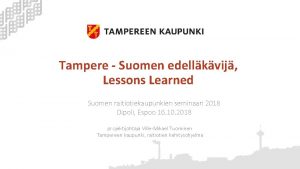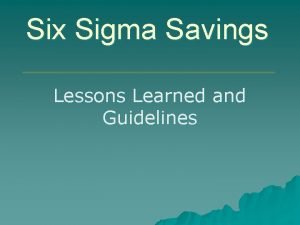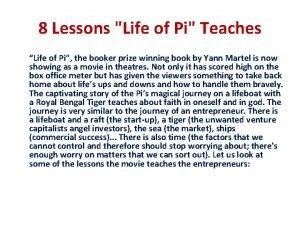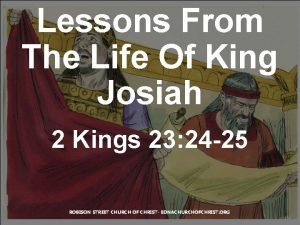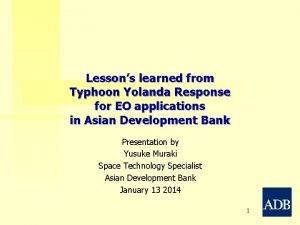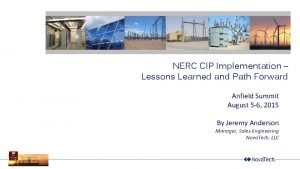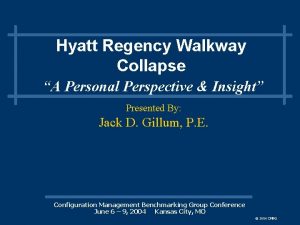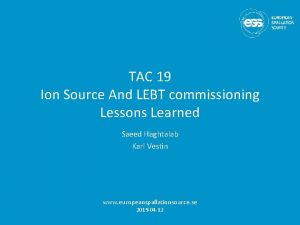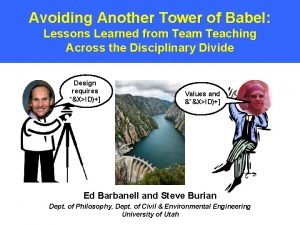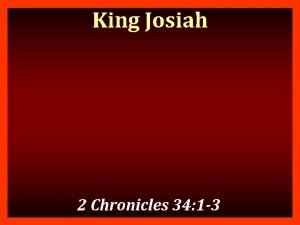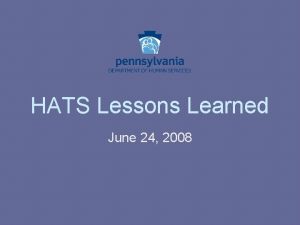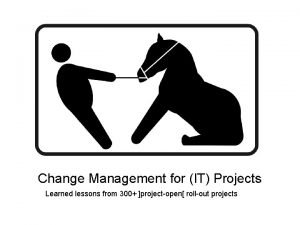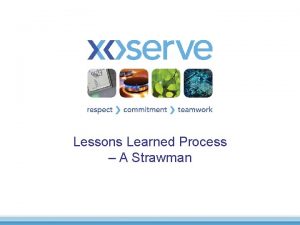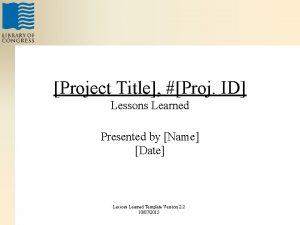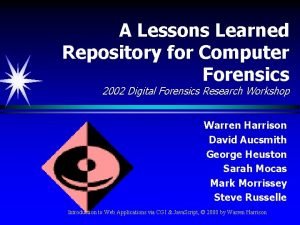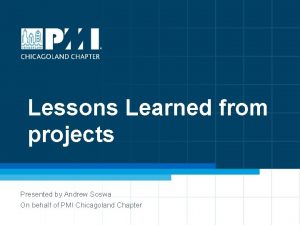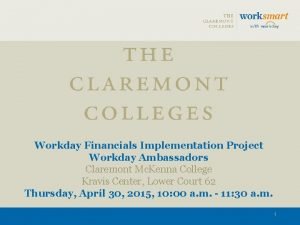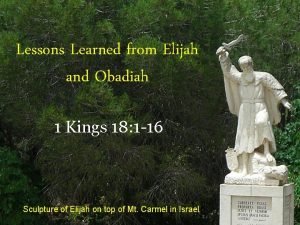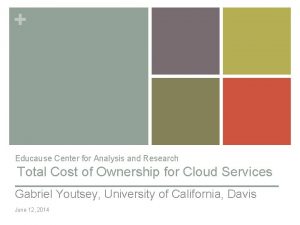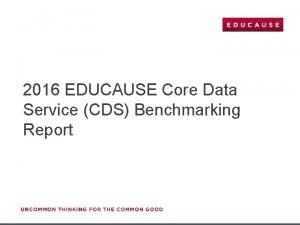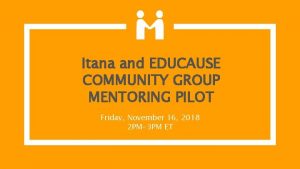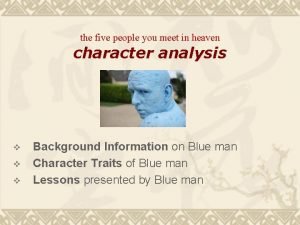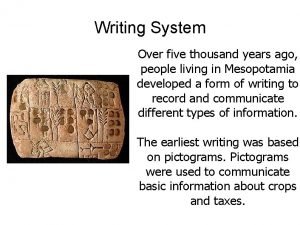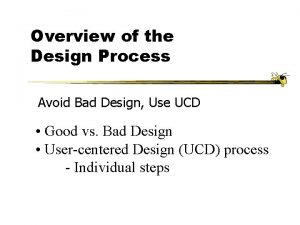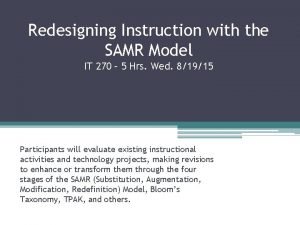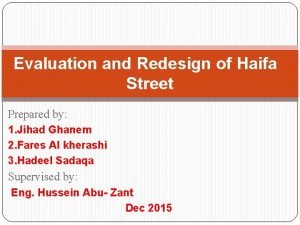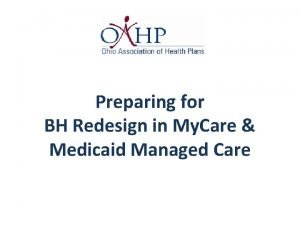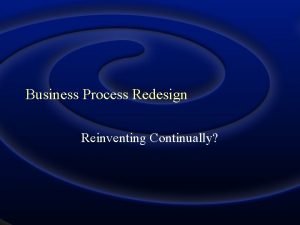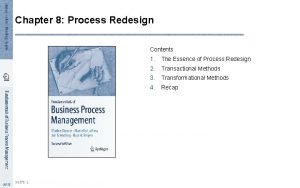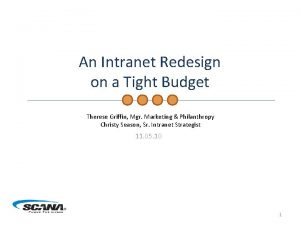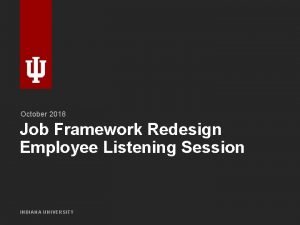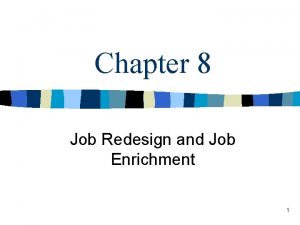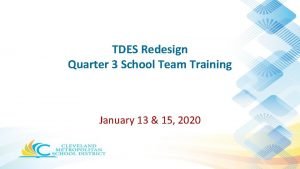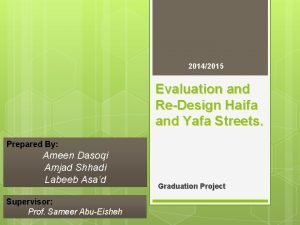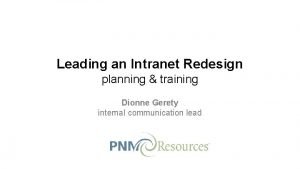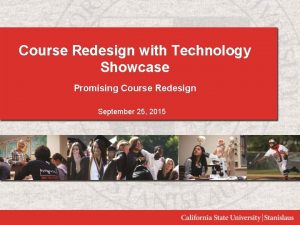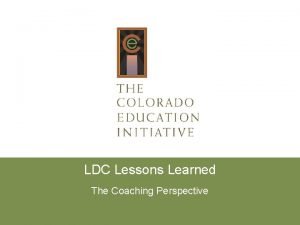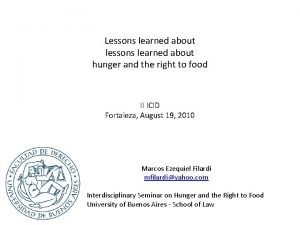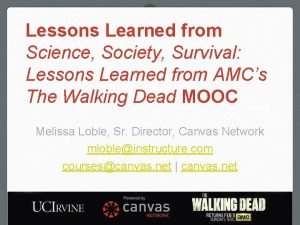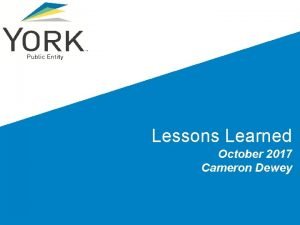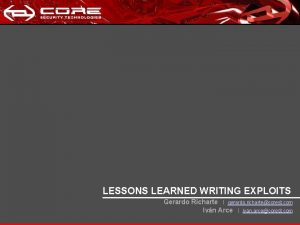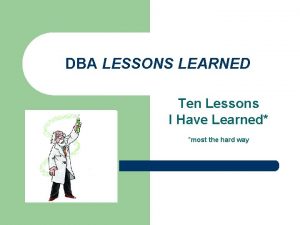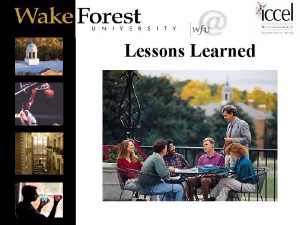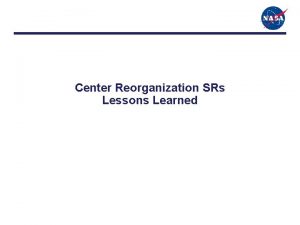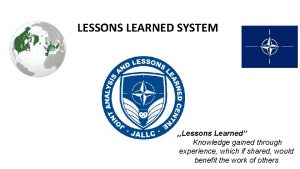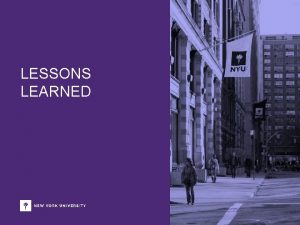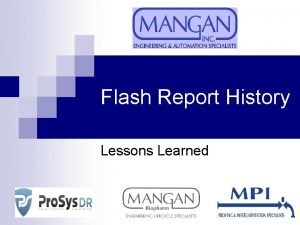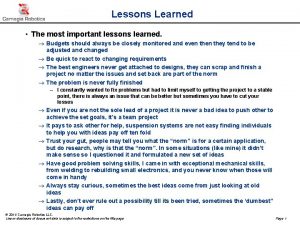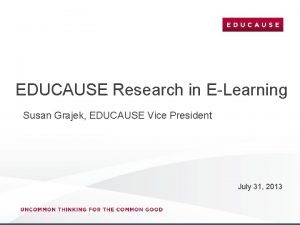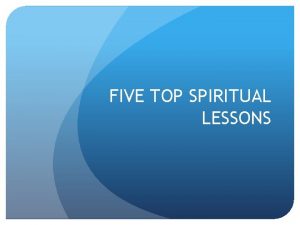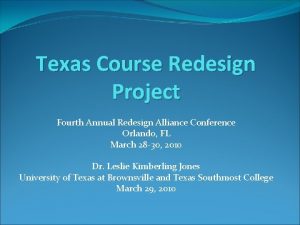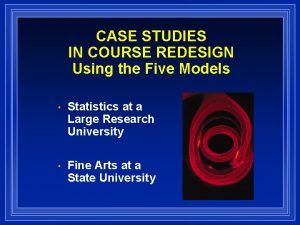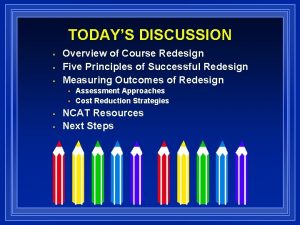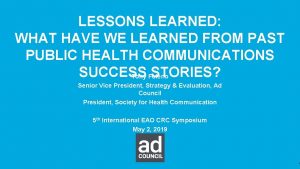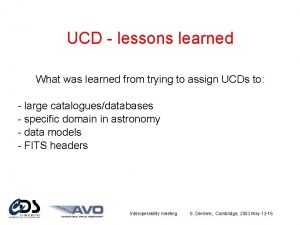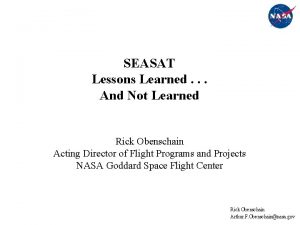Five Years of Course Redesign Lessons Learned EDUCAUSE














































- Slides: 46

Five Years of Course Redesign: Lessons Learned EDUCAUSE Learning Initiative 2010 Annual Meeting Austin, Texas January 20, 2010

Goals for today �Share why we thought that it was important to have a serious look at how we teach undergraduates at UNT �Provide a brief overview of the foundations of our course redesign �Describe how the Next Generation Course Redesign™ Project works at UNT �Demonstrate two NGen courses �Discuss the barriers to real course redesign �“Next Generation Course Redesign” in the Nov/Dec issue of Change �Play “What’s the Deal” in J/K 6 th Floor (lunch room) right after this presentation

Why Redesign Large Enrollment Undergraduate Courses?

The “Perfect Storm” �Bad News �High DFW rates �Demographics (higher and more diverse enrollments) �Financial (tuition cannot keep exceeding CPI) �Accountability � Good News �Knowledge of learning �Emergence of digital tools

What Do We Know About College Students and How They Learn? �Brain Research �The role of neural networks �Every network can be traced back to an experiential referent �Our students have “grown up digital” �Comfortable in a multimedia information-ubiquitous environment �Social networking is second nature �Cognitive development is an important goal �Most entering freshmen are at Kegan’s 3 rd stage �College experience must encourage a “discipline of inquiry”

�We know that, if we provide an active learning experience that allows students to engage with the content, each other, and instructors, they can and will think critically and develop cognitively.

Goals of the UNT QEP �To improve student learning outcomes in large enrollment undergraduate courses �To have a university-wide impact through the establishment of a Community of Practice and the creation of redesign that is both sustainable and replicable

(Translation) Goals: �Students think, work hard, like what they are doing, get good grades that mean something, and graduate �Doesn’t cost more and uses less space �Faculty have fun

UNT’s Transformational QEP Goal

Next Generation Course Redesign™ is a Process… �Faculty teams redesign 4 -6 courses each year (twoyear commitment) �“Choreographed” Process �Retreats �Monthly meetings with teams of faculty and staff �Institution-wide forums �End-of-pilot meetings �End-of-project meetings

Next Generation Course Redesign™ �The redesign occurs within an interdisciplinary Community of Practice �QEP Faculty Fellows have the option of being designated Senior Faculty Fellows

Creating a Culture of Reflection �Promulgate the philosophy of “never ending redesign” �Schedule small group meetings with the majority of time devoted to reflection and discussion �Provide opportunities for ongoing virtual discussion �Promote assessment-driven change

Next Generation Course Redesign™ also has products. NGen Courses have: �Clearly articulated student learning outcomes that include outcomes representing higher level learning. �Test items that match the student learning outcomes. �An assessment plan that shows how the test items map to the outcomes.

Common Assessment Across All NGen Courses � Preference for Course Format Survey (NGen vs. Traditional) � Attitude Toward Subject (pre/post) � LEP Survey of Cognitive Development (pre/post) � Raw score distributions

NGen Courses have: �Large group lectures (0 -12 contact hours) �Small group experiential learning (14 -23 contact hours) �Media-rich interactive online environment (18 -27 contact hours) These are the “building blocks” for an NGen course.

In NGen, Lectures are best used to: �Create interest and motivation and provide assurance that the students can be successful �Clarify and expand upon, rather than deliver, content �Model the acquisition of knowledge in the field, e. g. , “How does a historian/chemist/sociologist approach a research question? �Present the critical lower level concepts to provide scaffolding for higher level concepts

In NGen, Experiential Learning Activities are best used to: �Introduce an emotional component (brain-based learning) �Analyze, evaluate, and synthesize �Present and defend newly-acquired hypotheses �Provide collaborative, cooperative, and academic controversy activities that encourage thinking critically from multiple perspectives

Experiential Learning Example: U. S. History II �Dam It! The Battle Over Hetchy

Dilemma! �If I use experiential learning in my class, how am I going to “cover” all of the material?

In NGen, Online Learning Activities are best use to: �Acquire lower level learning to free up time for inclass experiential learning �Chunk content to overcome working memory limits �Provide low-stakes assessments such as quizzes for practice and confidence building �Provide psychomotor experiences �Provide concrete experiences that are guided and efficient

Next Generation Course Redesign™ �UNT offers 19 NGen Courses �Art History, Biology I, Computer Applications, U. S. History I & II, Human Development, World Literature, Principles of Language Study, Business Communications, Occupational Health, Music Appreciation, Developmental Math/College Algebra, Intro to Communications, Modernism and the Visual Arts, Organic Chemistry, American Government I, World Literature Since the Renaissance, and Sociology of Disasters �With six more in development (Biology II, Motor Development, Survey of Mathematics, Global Marketing Concepts, American Government II, and Individuals and Society)

Next Generation Course Redesign™: Example �BIOL 1710 Principles of Biology Dr. Lee Hughes Department of Biology

Blended Course Format �Principles of Biology I (first in 2 course majors sequence) �First offered as a blended course in Fall 2006 �One meeting/week (1. 5 hours) - large group lecture format (>100 students) taught by instructor �One meeting/week (1 hour) - small group recitation (<30 students) taught by teaching assistant �One online module each week (approximately 60% of new material is introduced online) �Large lecture meetings retain lecture format with the addition of active learning components �Recitation designed to include group activities, problems-based learning (case studies), and active learning strategies

Sample Weekly Outlines Week 1 L: Course Introduction R: #1 Recitation Introduction O: Course Structure and Expectations, Scientific Method Ch. 1, 2, 3 Modules 1, 2 Week 2 L: #1 Basic chemistry R: #2 Case Study: Scientific Method O: Biological Chemistry Ch. 4, 5 Module 3 Week 3 L: #2 Origin of Life. The first cells. R: #3 Biological Chemistry Activities O: . Cell Types and Structures Ch. 6 Module 4

Lecture Meeting Strategies �Ability to focus on processes rather than definitions �Incorporation of small group worksheets, concept maps, discussion questions, or quizzes in some meetings �Example of Active Strategy: Atoms

Online Strategies �Introduce concepts and provide a focus on important topics from the textbook readings �Provide links to external website readings or activities for exploration of the topic �Include reinforcing activities, assignments, or class discussions �Mastery quizzes

Recitation Strategies �Small Group Activities �Students are actively engaged in the material �NO lecturing by the teaching assistant and NO rehash of course lectures �Examples: Case studies, “Jeopardy”, Organelle Pageant

Example Interaction Nucleotide Building

Student Success Comparison (all enrolled students)

Would Students Do It Again? �Students in the blended course were asked: “If you were to start this course over again, would you prefer a traditional face-to-face format, or would you prefer the N-Gen (blended) redesign format you are experiencing? ” 80% said they would take the blended course (252 out of 315 completing the survey, Fall 2007 -Fall 2008)

Development Process �Enormous amounts of reevaluation during/following pilot semester �Minor tweaking in subsequent semester �Course design has been static for several years during collection of assessment data on whole course measures �Now ready to begin detail analysis of individual components in order to better refine the elements of the course

SOCI 3560: Sociology of Disaster Redesign Nicole Dash, Ph. D Associate Professor, Sociology Director, UNT Core Academy

Why Redesign? � Large Enrollment � No Textbooks � 90% Lecture � Students struggling to connect what they learned with real life situation

Redesigned Model � 10% Lecture: First two class periods only � 50% Online: 9 Online Modules � 10% Online Activities and Projects Low Risk Quizzes at end of Modules � Wiki Project: Disaster Case Studies � � 30% Small Group Experiential Learning Activities Design an Effective Warning Message � Stratified Monopoly and Disaster Scenario � Mock City Commission �

Stratified Monopoly � Student Learning Outcome Driven � Actual SLO: Investigate how social structures (such as race, class, and gender) generates disaster vulnerability and privilege � Monopoly as Simulation (Dr. Brenda Mc. Coy, Co-Creator) � Change the rules of the game to reflect social conditions in the real world to simulate social position � Use simulated social position in a rule-based disaster scenario � Goal: if the simulated social position was real, what would happen to you, your family and community in a disaster

Stratified Monopoly Rules � Rules for Race � Red players may only buy property from Mediterranean Avenue (Purple) through New York Avenue (Orange). Red players may not buy Red, yellow, green & blue properties. � Red players will only receive $150 each time they pass “GO” � Rules for Gender � Any woman rolling a “ 9” on the die loses the next 3 turns after advancing 9 spaces � Women passing “GO” will receive $150 instead of $200 � If men draw any chance card giving them money, they have “divorced. ” � They must pay child support to the bank in the amount of $25 every time they pass GO for the remainder of the game � Rules for Class Cash to start Player 1 Male Player 2 Male Player 3 Female Player 4 Female Player 5 Male Player 6 Female $900 $3750 $0 $1500 $200 $450

Disaster Scenario RULES (All values based on Total Assets): � All hazard events happen three days before the end of the month. � If you earned less than $450, you don't own a car � If you earned less than $1, 200, you don't own a house, you rent � If you are a renter and earned less than $800, you do not have renter’s insurance � If you have less than $250 of total assets, you are homeless. � If you're a minority all your family members live within a mile or two of each other � If you earned less than $2500. 00, you have done no mitigation. (no shutters, no tying down of roof, no earthquake or flood protection). You don't have earthquake insurance, and if insured, you are under insured. If you're a minority, you have insurance with a small insurance company that will pay only 50% of your losses at the most, but also may go out of business. � At least one minority member in your group is not a native English speaker. Don’t forget your children

Disaster Scenario Hurricane Welcome to sunny Key West, Florida! Key West is located at the end of a 150 mile stretch of islands just south of the mainland of Florida. Key West is a microcosm of hotels, bed and breakfast Inns, shops, bars and homes. The average home is valued at about $266, 000. However, with a large tourist industry and services for these tourists, low paying jobs are quite numerous. The majority of individuals who can’t afford a home in the area either rents part of a house or lives in older, run down mobile homes hidden in different areas of the island. For all hurricanes, everyone is in a mandatory evacuation zone. The closest evacuation shelter is in Miami, Florida over 150 miles to the North. There is one major road that goes from Key West to Miami, and over 25 bridges along it, including a 7 mile long bridge just north of Key West. Evacuation is usually staged with tourists and visitors being the first to leave, followed by residents. However, keep in mind that Key West is just one city along this stretch of islands. While Key West is trying to evacuate, others are attempting it as well. The National Hurricane Center is tracking Hurricane Niki as it spins in the Atlantic Ocean All the computer models indicate that the storm is tracking for a major strike some where near Key West. Residents are being urged to prepare their properties for the storm, and to initiate evacuation plans as soon as possible. The prediction is that hurricane force winds should be felt on the island within forty-eight hours. You and the others in your team live in Key West. You need to protect your home and get out as soon as possible. Develop a plan for each of your team members. Make sure you consider all the factors that might influence how well you prepare and protect. What do you think you’ll find when you get back. What happens next?

Preliminary Findings � Monopoly Related SLO: �Over 90% of students attained the desired knowledge. �Starting to Analyze Data: �Majority preferred Next-Gen Model to traditional model �All students who attended class and engaged in activities passed the class �Only failures were students who consistently missed projects and assignments �Higher drop rates

There is “pushback” �“Now can we stop playing games and learn Physics? ” �“Active learning. . is a philosophy and movement that portents trouble for the future of higher education and the professoriate. It's no longer good enough to teach well; instead, professors must be ready to embrace newly developed methods of ‘engagement, ’ even as class enrollments skyrocket. The ‘new professor’ must make large classes as entertaining as video games--or else take students out for coffee and memorize their hobbies. ” �I just can’t take the “me” out of my teaching.

There are Significant Challenges! �Once you move beyond the small circle of innovators, there are formidable challenges �Lack of rewards �Hostility to change �Scheduling problems �Research vs. teaching demands �Entrenched and comfortable pedagogy

Addressing the Challenges �Extended Redesign Project (currently 9 years) �Nurtured Communities of Practice

Addressing the Challenges cont. � Created student demand for change � Presentations to advisors � Flyers, bookmarks, pens � Website

Addressing the Challenges cont. �Working to change the recognition/reward system �Creation of professional career track for instructors �Development of institution-wide teaching assessment �Revision of workload documents

Enabling Transformative Course Redesign � 3 P’s �Passion �Project Management �Persistence

Discussion For more information: Nov/Dec issue of Change Next Generation Course Redesign™ Forthcoming from Peter Lang Publishing Dr. Niki Dash Nicole. Dash@unt. edu Dr. Lee Hughes Lee. Hughes@unt. edu Dr. Phil Turner Philip. Turner @ unt. edu
 The sounding cataract haunted me
The sounding cataract haunted me Lessons learned suomeksi
Lessons learned suomeksi Six sigma lessons learned
Six sigma lessons learned Lessons learned faa
Lessons learned faa What does life of pi teach us
What does life of pi teach us Contest on mount carmel
Contest on mount carmel Is josiah luke a dwarf
Is josiah luke a dwarf Typhoon yolanda lessons learned
Typhoon yolanda lessons learned Nerc lessons learned
Nerc lessons learned Hyatt regency walkway
Hyatt regency walkway Tac lessons learned
Tac lessons learned Hydrotopia
Hydrotopia 2 chronicles 34 children's lesson
2 chronicles 34 children's lesson Lessons learned ground rules
Lessons learned ground rules Lessons not learned in blood
Lessons not learned in blood Change management lessons learned
Change management lessons learned Strawman process
Strawman process Risk management lessons learned
Risk management lessons learned Lessons learned repository
Lessons learned repository Pmbok lessons learned
Pmbok lessons learned What do we learn from ants
What do we learn from ants Workday implementation lessons learned
Workday implementation lessons learned 1 kings 21 lessons
1 kings 21 lessons Educause center for analysis and research
Educause center for analysis and research Educause cds
Educause cds Educause community groups
Educause community groups 300 solar years to lunar years
300 solar years to lunar years How long is “four score and seven years”?
How long is “four score and seven years”? Goat years to human years
Goat years to human years The five people you meet in heaven lessons
The five people you meet in heaven lessons We have been running the youth camp ... five years.
We have been running the youth camp ... five years. Why did the barley sign change shape
Why did the barley sign change shape Redesign bad honnef
Redesign bad honnef Technology allows for significant task redesign
Technology allows for significant task redesign Redesign haifa
Redesign haifa Principles of business process reengineering
Principles of business process reengineering Bh redesign
Bh redesign Radical redesign of business processes
Radical redesign of business processes Redesign orbit
Redesign orbit Intranet redesign
Intranet redesign Job framework redesign
Job framework redesign What is job analysis
What is job analysis Job redesign meaning
Job redesign meaning Quarter redesign
Quarter redesign Redesign haifa
Redesign haifa Intranet redesign project plan
Intranet redesign project plan Coast guard bpr
Coast guard bpr

